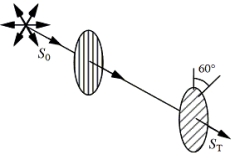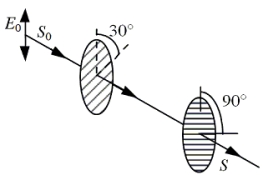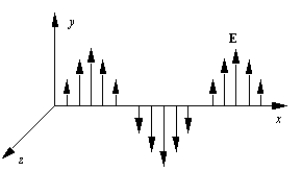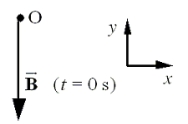A) 1.0 × 109 Hz
B) 1.3 × 108 Hz
C) 2.5 × 108 Hz
D) 3.8 × 108 Hz
E) 5.0 × 108 Hz
Correct Answer

verified
Correct Answer
verified
Multiple Choice
In 1980, a television station began broadcasting on channel 32 at a frequency of 582 MHz. The circuit contains an inductor with an inductance L = 4.15 × 10-4 H and a variable-capacitance C. Determine the value of C that allows this television station to be tuned in.
A) 2.92 × 10-12 F
B) 5.84 × 10-12 F
C) 1.80 × 10-12 F
D) 3.61 × 10-11 F
E) 1.10 × 10-11 F
Correct Answer

verified
Correct Answer
verified
Multiple Choice
Complete the following sentence: When electrons from a heated filament accelerate through vacuum toward a positive plate,
A) only an electric field will be produced.
B) only a magnetic field will be produced.
C) electromagnetic waves will be produced.
D) longitudinal waves will be produced.
E) neither electric nor magnetic fields will be produced.
Correct Answer

verified
Correct Answer
verified
Multiple Choice
The most convincing evidence that electromagnetic waves are transverse waves is that
A) they can be polarized.
B) they carry energy through space.
C) they can travel through a material substance.
D) they do not require a physical medium for propagation.
E) all electromagnetic waves travel with the same speed through vacuum.
Correct Answer

verified
Correct Answer
verified
Multiple Choice
Unpolarized light of intensity S0 passes through two sheets of polarizing material whose transmission axes make an angle of 60° with each other as shown in the figure. What is the intensity of the transmitted beam, ST? 
A) S0/4
B) S0/8
C) 3S0/4
D) S0/16
E) zero
Correct Answer

verified
Correct Answer
verified
Multiple Choice
A linearly polarized beam of light is incident upon a group of three polarizing sheets which are arranged so that the transmission axis of each sheet is rotated by 45° with respect to the preceding sheet as shown. What fraction of the incident intensity is transmitted? 
A) 1/8
B) 1/4
C) 3/8
D) 1/2
E) 3/4
Correct Answer

verified
Correct Answer
verified
Multiple Choice
An astronomer observes electromagnetic waves emitted by oxygen atoms in a distant galaxy that have a frequency of 5.710 × 1014 Hz. In the laboratory on earth, oxygen atoms emit waves that have a frequency of 5.841 × 1014 Hz. Determine the relative velocity of the galaxy with respect to the astronomer on the earth. Note: The speed of light is 2.9979 × 108 m/s.
A) 6.724 × 106 m/s, away from earth
B) 6.724 × 106 m/s, toward earth
C) 2.931 × 108 m/s, away from earth
D) 4.369 × 104 m/s, toward earth
E) 4.369 × 104 m/s, away from earth
Correct Answer

verified
Correct Answer
verified
Multiple Choice
Which one of the following types of wave is fundamentally different than the other four?
A) radio waves
B) sound waves
C) gamma rays
D) ultraviolet radiation
E) visible light
Correct Answer

verified
Correct Answer
verified
Multiple Choice
Complete the following sentence: The various colors of visible light differ in
A) frequency only.
B) wavelength only.
C) their speeds in a vacuum.
D) both frequency and wavelength.
E) both frequency and their speed in a vacuum.
Correct Answer

verified
Correct Answer
verified
Multiple Choice
A radio wave sent from the surface of the earth reflects from the surface of the moon and returns to the earth. The elapsed time between the generation of the wave and the detection of the reflected wave is 2.6444 s. Determine the distance from the surface of the earth to the surface of the moon. Note: The speed of light is 2.9979 × 108 m/s.
A) 3.7688 × 108 m
B) 3.8445 × 108 m
C) 3.9638 × 108 m
D) 4.0551 × 108 m
E) 7.9276 × 108 m
Correct Answer

verified
Correct Answer
verified
Multiple Choice
The figure shows the time variation of the magnitude of the electric field of an electromagnetic wave produced by a wire antenna.  -What is the rms value of the magnitude of the magnetic field?
-What is the rms value of the magnitude of the magnetic field?
A) 1.4 × 10-8 T
B) 2.4 × 10-8 T
C) 3.3 × 10-8 T
D) 4.6 × 10-8 T
E) 5.4 × 10-8 T
Correct Answer

verified
Correct Answer
verified
Multiple Choice
A laser uniformly illuminates an area with green light that has an average intensity of 550 W/m2. What is the rms value of the electric field of this light?
A) 322 N/C
B) 405 N/C
C) 455 N/C
D) 643 N/C
E) 891 N/C
Correct Answer

verified
Correct Answer
verified
Multiple Choice
A linearly polarized electromagnetic wave is sent through two sheets of polarizing material. The first sheet, A, is oriented so that its transmission axis makes an angle of 30° with respect to the incident electric field of the wave. The second sheet, B, is oriented so that its transmission axis makes an angle of 90° with the incident electric field of the wave. The incident beam has an electric field of peak magnitude E0 and average intensity S0.  -Suppose that A and B are interchanged so that the wave is first incident upon B. What is the average wave intensity after passing through both polarizing sheets?
-Suppose that A and B are interchanged so that the wave is first incident upon B. What is the average wave intensity after passing through both polarizing sheets?
A) 0.19S0
B) 0.34S0
C) 0.43S0
D) 0.50S0
E) zero
Correct Answer

verified
Correct Answer
verified
Multiple Choice
The electric field E of an electromagnetic wave traveling the positive x direction is illustrated in the figure. This is the wave of the radiation field of an antenna. What are the direction and the phase relative to the electric field of the magnetic field at a point where the electric field is in the negative y direction? Note: The wave is shown in a region of space that is a large distance from its source. 
A) +y direction, in phase
B) -z direction, 90° out of phase
C) +z direction, 90° out of phase
D) -z direction, in phase
E) +z direction, in phase
Correct Answer

verified
Correct Answer
verified
Multiple Choice
An electromagnetic wave has an electric field with peak value 250.0 N/C. What is the average energy delivered to a surface with area 0.75 m2 by this wave in one hour?
A) 8.3 × 104 J
B) 1.6 × 105 J166 J
C) 2.2 × 105 J
D) 3700 J
E) 9960 J
Correct Answer

verified
Correct Answer
verified
Multiple Choice
Electromagnetic waves are radiated uniformly in all directions from a source. The rms electric field of the waves is measured 35 km from the source to have an rms value of 0.012 N/C. Determine the average total power radiated by the source.
A) 5.9 × 103 W
B) 9.0 × 103 W
C) 2.4 × 104 W
D) 6.3 × 104 W
E) 1.6 × 105 W
Correct Answer

verified
Correct Answer
verified
Multiple Choice
The electromagnetic wave of the radiation field from a wire antenna travels toward the plane of your paper (which is in the -z direction) . At time t = 0 s, the wave strikes your paper at normal incidence. The magnetic field vector at point O in the figure points in the -y direction and has a magnitude of 4.0 × 10-8 T. The frequency of the wave is 1.0 × 1016 Hz.  -What is the magnitude of the magnetic field at point O at time t = 5.0 × 10-17 s?
-What is the magnitude of the magnetic field at point O at time t = 5.0 × 10-17 s? 
A) 1.0 × 10-8 T
B) 2.0 × 10-8 T
C) 3.0 × 10-8 T
D) 4.0 × 10-8 T
E) 5.0 × 10-8 T
Correct Answer

verified
Correct Answer
verified
Multiple Choice
Which one of the following will not generate electromagnetic waves or pulses?
A) a steady direct current
B) an accelerating electron
C) a proton in simple harmonic motion
D) an alternating current
E) charged particles traveling in a circular path in a mass spectrometer
Correct Answer

verified
Correct Answer
verified
Multiple Choice
A distant space probe is programmed to emit a radio signal toward Earth at regular time intervals. One such pulse arrives on Earth 6.92 s after it is emitted from the probe. What is the approximate distance from the Earth to the probe?
A) 8.76 × 109 m
B) 7.40 × 1010 m
C) 6.94 × 109 m
D) 2.08 × 109 m
E) 3.50 × 1010 m
Correct Answer

verified
Correct Answer
verified
Multiple Choice
Note the different types of electromagnetic radiation:  Which list correctly ranks the electromagnetic waves in order of increasing frequency?
Which list correctly ranks the electromagnetic waves in order of increasing frequency?
A) 2, 3, 4, 5, 6, 1
B) 2, 5, 4, 1, 6, 3
C) 2, 5, 4, 6, 1, 3
D) 3, 1, 6, 4, 5, 2
E) 3, 6, 1, 4, 5, 2
Correct Answer

verified
Correct Answer
verified
Showing 41 - 60 of 66
Related Exams